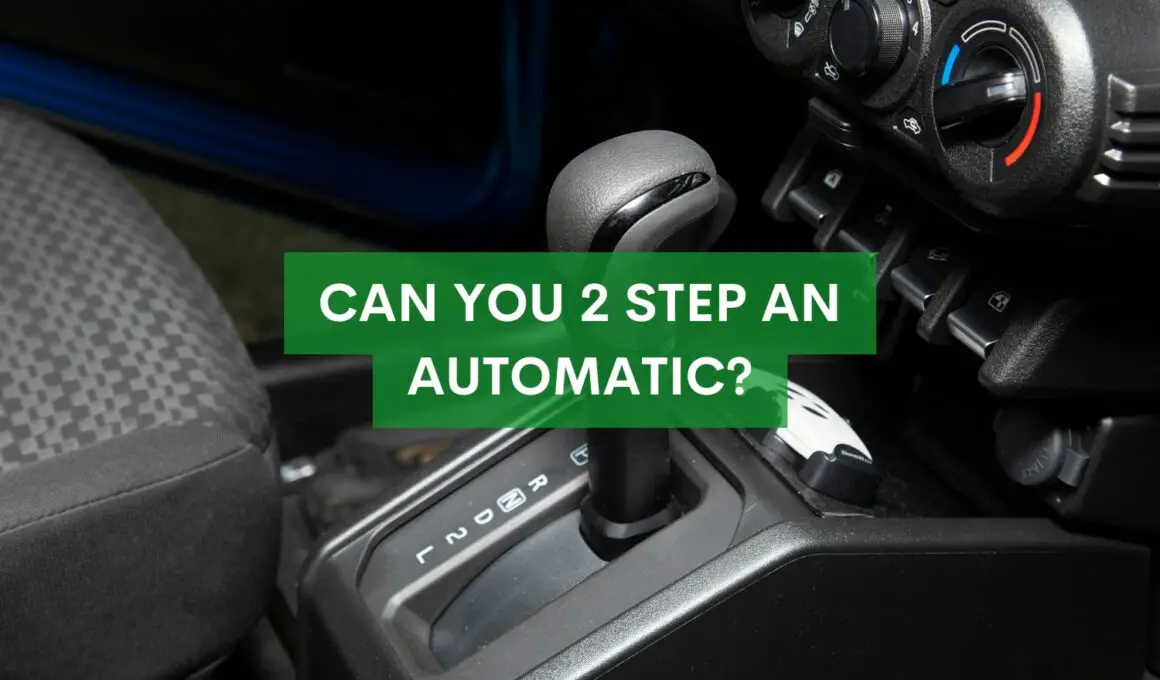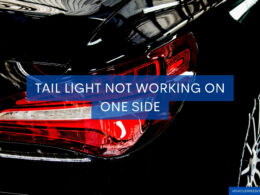In This Article Show
As an experienced mechanic with over a decade under my belt, I’ve encountered many questions from car owners, racing fans, and fellow mechanics. One intriguing question that often arises is, “Can you 2-step an automatic?” This simple inquiry can spark a surprisingly complex discussion, and that’s what we’re going to unpack today.
Firstly, let me assure you that this article is designed to cater to both novices and those with a solid understanding of the automotive world. My thirteen years of hands-on mechanical experience have given me the ability to diagnose and fix vehicles and break down complex automotive concepts into simple, understandable language.
In this post, we aim to explore the concept of 2-step launch control, how it fits into the realm of automatic transmissions, and whether it’s truly feasible to set up in an automatic vehicle.
When it comes to cars, especially the aspect of performance driving, 2-step launch control is a term you’re likely to encounter. This nifty mechanism plays a significant role in high-performance manual transmission vehicles.
But what about automatics? Can the same principle apply? To answer this, we’ll delve into the intricacies of a 2-step launch control, understand the workings of an automatic transmission, and finally address the possibility and practicality of a 2-step system in an automatic car.
What is a 2-Step Launch Control?
As we set our foot on the throttle of this discussion, it’s important first to understand what exactly a 2-step launch control is. A topic often discussed in the realm of high-performance driving and racing, 2-step launch control is a system designed to improve a vehicle’s acceleration from a standing start.
Typically found in manual transmission vehicles, this system works by limiting the engine’s RPM (revolutions per minute) at a pre-set level when the vehicle is stationary. The “2-step” in its name refers to the two distinct RPM limits that the system manages. The first limit is for when the car is idle and the clutch is engaged. The second comes into play when the clutch is disengaged, and the car is ready to launch.
This mechanism plays a critical role in allowing the driver to keep the engine in its power band (the RPM range where the engine performs optimally) and ready for a quick launch, without over-revving or causing unnecessary wear.
The result is faster acceleration, better control, and a higher degree of consistency when it comes to drag racing or high-performance driving.

Understanding Automatic Transmission
The world of automatic transmission might seem complex at first glance, but in essence, it’s designed to simplify the driving experience. It does this by automatically shifting the vehicle’s gears as it moves, hence the name ‘automatic’. This contrasts with manual transmission, where the driver must manually change gears.
Automatic transmissions use a complex series of sensors and hydraulic fluids to determine when gear shifts are required, based on various factors like speed and engine load. The main components of an automatic transmission system are the torque converter, planetary gear set, and hydraulic system.
The torque converter connects the engine and the transmission, taking the place of a manual clutch. It allows the car to stop in gear while the engine is still running. The planetary gear set is the core component that provides the different gear ratios for an automatic transmission. The hydraulic system controls the shifting of the gears based on the fluid pressure within the system.
For many drivers, the simplicity and ease of use offered by automatic transmission make it an appealing choice. There’s no need to worry about stalling or gear shifting, allowing you to focus more on the road and other aspects of driving. However, the relative lack of control compared to a manual transmission can be a disadvantage in certain driving situations, such as performance or sport driving.
One important question that often arises in the context of automatic transmission is whether advanced features like a 2-step launch control system can be implemented. Is it feasible or even beneficial?
Can You 2-Step an Automatic Transmission?
This is the question that has brought many of us here today. As an experienced mechanic who has worked with countless automatic and manual vehicles, I can affirm that the concept of 2-step launch control is indeed applicable to automatic transmissions. However, the implementation and results can be different compared to those in manual vehicles.
First, let’s address the feasibility. Most automatic transmissions are controlled electronically, which means that, with the right aftermarket devices or software, you can alter how the transmission operates. This could involve introducing a 2-step launch control system that essentially mimics the RPM limitation effect seen in manual cars.
However, it’s crucial to understand that this isn’t a standard feature and requires some significant tweaking.
Now, onto the practicality. The main purpose of a 2-step launch control in manual transmissions is to help optimize acceleration from a stationary start, a common scenario in drag racing. For day-to-day driving situations, the benefits may not be as pronounced.
Additionally, due to the automatic nature of gear shifting in automatic vehicles, the driver doesn’t have the same level of control over the engine’s RPM as in a manual car. This means the benefits of a 2-step launch control system might not be fully realized in an automatic.
It’s also worth mentioning that while this modification is possible, it may not always be advisable. Significant modifications to a car’s transmission system can potentially lead to wear and tear or even damage, especially if not done correctly. It’s always best to consult with a professional, such as a mechanic with years of experience, before making major alterations to your vehicle.
How to Set Up a 2-Step Launch Control in an Automatic Car
If you’re considering setting up a 2-step launch control in an automatic car, it’s crucial to understand that this isn’t a straightforward process. Remember, major alterations to your car should always be handled by professionals to ensure they’re done correctly and safely.
As an experienced mechanic, I cannot emphasize this enough. That said, here’s a general outline of how the process would typically go:
Understand Your Vehicle’s System
Every car is different. Before you begin, it’s important to understand your vehicle’s specifications, the type of automatic transmission it uses, and its electronic control capabilities.
Acquire the Necessary Equipment
Setting up a 2-step launch control system requires certain aftermarket parts or software. This may include a standalone ECU (Engine Control Unit) or a piggyback tuning device, depending on your car’s specifications.
Install the 2-Step Control Device
Once you’ve got the necessary equipment, the next step is the installation. This usually involves connecting the device to your car’s ECU, which controls the engine’s operations. Keep in mind that this is a delicate process and should be handled by a professional to avoid damaging your vehicle’s electronics.
Configure the RPM Limits
After installation, you’ll need to configure the RPM limits. This is where the real challenge lies in automatic cars, as the optimal RPM limit can differ based on numerous factors including the car’s make, model, and engine specifications.
Test the System
Once everything is set up, you’ll need to test the system to ensure it’s working correctly and safely. This should be done in a controlled environment, like a racetrack, to prevent any potential accidents on public roads.
It’s important to remember that setting up a 2-step launch control in an automatic car is not a common or straightforward process. It requires a good understanding of car mechanics, precision, and professional experience. If done incorrectly, it can cause damage to your car and potentially void your warranty.
FAQs About 2-Step Launch Control in Automatic Transmission Cars
Does 2-step launch control damage my automatic transmission?
While a properly installed and configured 2-step launch control system should not inherently damage your transmission, it’s important to remember that any significant modification can potentially lead to increased wear and tear, especially if not done correctly. Always consult with a professional before making such modifications.
Can all automatic cars have a 2-step launch control?
Not all automatic cars are suitable for a 2-step launch control system. The feasibility largely depends on the type of automatic transmission and the car’s ECU.
Will 2-step launch control make my automatic car faster?
The primary purpose of a 2-step launch control is to optimize a car’s acceleration from a stationary start. It does not increase the car’s top speed. So, while it may help your car reach its top speed quicker, it will not make your car faster in terms of maximum speed.
Is 2-step launch control legal?
Laws about car modifications can vary widely depending on your location. Some regions may have restrictions on such modifications, especially if they increase noise levels. Always check local regulations before making significant modifications to your vehicle.
Can I install a 2-step launch control system myself?
As an experienced mechanic, I strongly advise against attempting to install a 2-step launch control system yourself unless you have professional training. Incorrect installation can damage your vehicle’s electronics or void its warranty.
Wrapping it up
To bring our journey to a close, yes, it is possible to 2-step an automatic transmission. However, it’s not a straightforward process, and the benefits might not be as significant as they are in manual vehicles.
This modification should only be undertaken with a thorough understanding of your vehicle’s system, the right equipment, and professional guidance. As an experienced mechanic, my advice is always to consider the potential risks and benefits carefully before making significant modifications to your vehicle.










